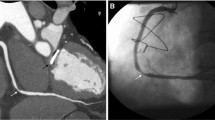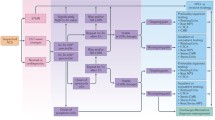Abstract
Stable chest pain is a common symptom with multiple potential causes. Non-invasive imaging has an important role in diagnosis and guiding management through the assessment of coronary stenoses, atherosclerotic plaque, myocardial ischaemia or infarction, and cardiac function. Computed tomography (CT) provides the anatomical evaluation of coronary artery disease (CAD) with the assessment of stenosis, plaque type and plaque burden, with additional functional information available from CT fractional flow reserve (FFR) or CT myocardial perfusion imaging. Stress magnetic resonance imaging, nuclear stress myocardial perfusion imaging, and stress echocardiography can assess myocardial ischaemia and other cardiac functional parameters. Coronary CT angiography can be used as a first-line test for many patients with stable chest pain, particularly those with low to intermediate pre-test probability. Functional testing may be considered for patients with known CAD, where the clinical significance is uncertain based on anatomical testing, or in patients with high pre-test probability. This practice recommendations document can be used to guide the selection of non-invasive imaging for patients with stable chest pain and provides brief recommendations on how to perform and report these diagnostic tests.
Key Points
-
The selection of non-invasive imaging tests for patients with stable chest pain should be based on symptoms, pre-test probability, and previous history.
-
Coronary CT angiography can be used as a first-line test for many patients with stable chest pain, particularly those with low to intermediate pre-test probability.
-
Functional testing can be considered for patients with known CAD, where the clinical significance of CAD is uncertain based on anatomical testing, or in patients with high pre-test probability.
Key recommendations
-
Non-invasive imaging is an important part of the assessment of patients with stable chest pain. The selection of non-invasive imaging test should be based on symptoms, pre-test probability, and previous history. (Level of evidence: High).
-
Coronary CT angiography can be used as a first line test for many patients with stable chest pain, particularly those with low to intermediate pre-test probability. CT provides information on stenoses, plaque type, plaque volume, and if required functional information with CT fractional flow reserve or CT perfusion. (Level of evidence: High).
-
Functional testing can be considered for patients with known CAD, where the clinical significance of CAD is uncertain based on anatomical testing, or in patients with high pre-test probability. Stress MRI, SPECT, PET, and echocardiography can provide information on myocardial ischemia, along with cardiac functional and other information. (Level of evidence: Medium).





Similar content being viewed by others
Change history
22 April 2024
Source Line layout was corrected.
Abbreviations
- CAD:
-
Coronary artery disease
- CCTA:
-
Coronary computed tomography angiography
- FFR:
-
Fractional flow reserve
- ICA:
-
Invasive coronary angiography
- IVUS:
-
Intravascular ultrasound
- MACE:
-
Major adverse cardiovascular events
- OCT:
-
Optical coherence tomography
References
Knuuti J, Wijns W, Saraste A et al (2020) 2019 ESC guidelines for the diagnosis and management of chronic coronary syndromes. Eur Heart J 41:407–477
Writing Committee M, Gulati M, Levy PD et al (2022) 2021 AHA/ACC/ASE/CHEST/SAEM/SCCT/SCMR guideline for the evaluation and diagnosis of chest pain: a report of the American College of Cardiology/American Heart Association Joint Committee on clinical practice guidelines. J Cardiovasc Comput Tomogr 16:54–122
Recent-onset chest pain of suspected cardiac origin: assessment and diagnosis. https://www.niceorguk/guidance/cg95
Douglas PS, Hoffmann U, Patel MR et al (2015) Outcomes of anatomical versus functional testing for coronary artery disease. N Engl J Med 372:1291–1300
Investigators S-H, Newby DE, Adamson PD et al (2018) Coronary CT angiography and 5-year risk of myocardial infarction. N Engl J Med 379:924–933
Group DT, Maurovich-Horvat P, Bosserdt M et al (2022) CT or invasive coronary angiography in stable chest pain. N Engl J Med 386:1591–1602
Dewey M, Siebes M, Kachelriess M et al (2020) Clinical quantitative cardiac imaging for the assessment of myocardial ischaemia. Nat Rev Cardiol 17:427–450
Schonenberger E, Martus P, Bosserdt M et al (2019) Kidney injury after intravenous versus intra-arterial contrast agent in patients suspected of having coronary artery disease: a randomised trial. Radiology 292:664–672
Le Ven F, Pontana F, Barone-Rochette G et al (2021) Position paper on stress cardiac MRI in chronic coronary syndrome: endorsed by the Societe Francaise de Radiologie (SFR) the Societe Francaise d’Imagerie CardioVasculaire (SFICV) and the Societe Francaise de Cardiologie (SFC). Diagn Interv Imaging 102:337–345
von Ballmoos MW, Haring B, Juillerat P, Alkadhi H (2011) Meta-analysis: diagnostic performance of low-radiation-dose coronary computed tomography angiography. Ann Intern Med 154:413–420
Williams MC, Moss AJ, Dweck M et al (2019) Coronary artery plaque characteristics associated with adverse outcomes in the SCOT-HEART study. J Am Coll Cardiol 73:291–301
Puchner SB, Liu T, Mayrhofer T et al (2014) High-risk plaque detected on coronary CT angiography predicts acute coronary syndromes independent of significant stenosis in acute chest pain: results from the ROMICAT-II trial. J Am Coll Cardiol 64:684–692
Maclean E, Cronshaw R, Newby DE, Nicol E, Williams MC (2023) Prognostic utility of semi-quantitative coronary computed tomography angiography scores in the SCOT-HEART trial. J Cardiovasc Comput Tomogr. https://doi.org/10.1016/j.jcct.2023.08.009
Cury RC, Blankstein R, Leipsic J et al (2022) CAD-RADS 2.0 - 2022 Coronary Artery Disease - reporting and data system an expert consensus document of the Society of Cardiovascular Computed Tomography (SCCT), the American College of Cardiology (ACC), the American College of Radiology (ACR) and the North America society of cardiovascular imaging (NASCI). J Cardiovasc Comput Tomogr. https://doi.org/10.1016/j.jcct.2022.07.002
Green R, Cantoni V, Acampa W et al (2021) Prognostic value of coronary flow reserve in patients with suspected or known coronary artery disease referred to PET myocardial perfusion imaging: a meta-analysis. J Nucl Cardiol 28:904–918
Murthy VL, Naya M, Foster CR et al (2011) Improved cardiac risk assessment with noninvasive measures of coronary flow reserve. Circulation 124:2215–2224
Celeng C, Leiner T, Maurovich-Horvat P et al (2019) Anatomical and functional computed tomography for diagnosing hemodynamically significant coronary artery disease. A Meta-Analysis. JACC Cardiovasc Imaging 12:1316–1325
Norgaard BL, Gaur S, Fairbairn TA et al (2022) Prognostic value of coronary computed tomography angiographic derived fractional flow reserve: a systematic review and meta-analysis. Heart 108:194–202
Chen MY, Rochitte CE, Arbab-Zadeh A et al (2017) Prognostic value of combined CT angiography and myocardial perfusion imaging versus invasive coronary angiography and nuclear stress perfusion imaging in the prediction of major adverse cardiovascular events: the CORE320 multicenter study. Radiology 284:55–65
Shah DJ, Kim HW, James O et al (2013) Prevalence of regional myocardial thinning and relationship with myocardial scarring in patients with coronary artery disease. JAMA 309:909–918
Torrado J, Buckley L, Duran A et al (2018) Restenosis, stent thrombosis, and bleeding complications: navigating between Scylla and Charybdis. J Am Coll Cardiol 71:1676–1695
Narula J, Chandrashekhar Y, Ahmadi A et al (2021) SCCT 2021 expert consensus document on coronary computed tomographic angiography: a report of the Society of Cardiovascular Computed Tomography. J Cardiovasc Comput Tomogr 15:192–217
Sun Z, Almutairi AM (2010) Diagnostic accuracy of 64 multislice CT angiography in the assessment of coronary in-stent restenosis: a meta-analysis. Eur J Radiol 73:266–273
Geering L, Sartoretti T, Mergen V et al (2023) First in-vivo coronary stent imaging with clinical ultra high resolution photon-counting CT. J Cardiovasc Comput Tomogr 17:233–235
Hillis LD, Smith PK, Anderson JL et al (2011) 2011 ACCF/AHA guideline for coronary artery bypass graft surgery: a report of the American College of Cardiology Foundation/American Heart Association Task Force on practice guidelines. Circulation 124:e652–e735
Chan M, Ridley L, Dunn DJ et al (2016) A systematic review and meta-analysis of multidetector computed tomography in the assessment of coronary artery bypass grafts. Int J Cardiol 221:898–905
Mergen V, Sartoretti T, Baer-Beck M et al (2022) Ultra-high-resolution coronary CT angiography with photon-counting detector CT: feasibility and image characterization. Invest Radiol 57:780–788
Williams MC, Kwiecinski J, Doris M et al (2020) Low-attenuation noncalcified plaque on coronary computed tomography angiography predicts myocardial infarction: results from the multicenter SCOT-HEART trial (Scottish Computed Tomography of the HEART). Circulation 141:1452–1462
Tzolos E, Williams MC, McElhinney P et al (2022) Pericoronary adipose tissue attenuation, low-attenuation plaque burden, and 5-year risk of myocardial infarction. JACC Cardiovasc Imaging 15:1078–1088
Eisenberg E, McElhinney PA, Commandeur F et al (2020) Deep learning-based quantification of epicardial adipose tissue volume and attenuation predicts major adverse cardiovascular events in asymptomatic subjects. Circ Cardiovasc Imaging 13:e009829
Acknowledgements
This paper was endorsed by the Executive Council of the European Society of Radiology (ESR) and the Executive Committee of the European Society of Cardiovascular Radiology (ESCR) in March 2024.
Funding
The authors state that this work has not received any funding.
Author information
Authors and Affiliations
Corresponding author
Ethics declarations
Guarantor
The scientific guarantor of this publication is Giuseppe Muscogiuri.
Conflict of interest
GM received a travel grant by Bracco. MCW has given talks for Canon Medical Systems, Siemens Healthineers and Novartis and performed consultancy for FEOPS. MCW is supported by the British Heart Foundation (FS/ICRF/20/26002). JRWM is supported by the National Institute for Health and Care Research (NIHR) Cambridge Biomedical Research Centre (BRC-1215-20014). RV is supported by an institutional research grant from Siemens Healthineers, and has received honorarium by Siemens Healthineers and Bayer for invited lectures. CL has received speaker honorarium from Siemens Healthineers, GE Healthcare and Bracco. HA has given presentations for Siemens. Healthcare. HA receives institutional grants from Bayer, Canon, Guerbet, and Siemens. HA is deputy editor of European Radiology. He has not taken part in the review or selection process of this article. JWM is a member of the European Radiology Scientific Editorial Board (Cardiac). He has not taken part in the review or selection process of this article.
Statistics and biometry
No complex statistical methods were necessary for this paper.
Informed consent
Written informed consent was not required.
Ethical approval
Institutional Review Board approval was not required.
Study subjects or cohorts overlap
Not applicable.
Methodology
-
Practice recommendations
Additional information
Publisher’s Note Springer Nature remains neutral with regard to jurisdictional claims in published maps and institutional affiliations.
This article belongs to the ESR Essentials series guest edited by Mark Dewey (Berlin/Germany).
Supplementary information
Rights and permissions
Springer Nature or its licensor (e.g. a society or other partner) holds exclusive rights to this article under a publishing agreement with the author(s) or other rightsholder(s); author self-archiving of the accepted manuscript version of this article is solely governed by the terms of such publishing agreement and applicable law.
About this article
Cite this article
Muscogiuri, G., Weir-McCall, J.R., Tregubova, M. et al. ESR Essentials: imaging in stable chest pain – practice recommendations by ESCR. Eur Radiol (2024). https://doi.org/10.1007/s00330-024-10739-y
Received:
Revised:
Accepted:
Published:
DOI: https://doi.org/10.1007/s00330-024-10739-y




